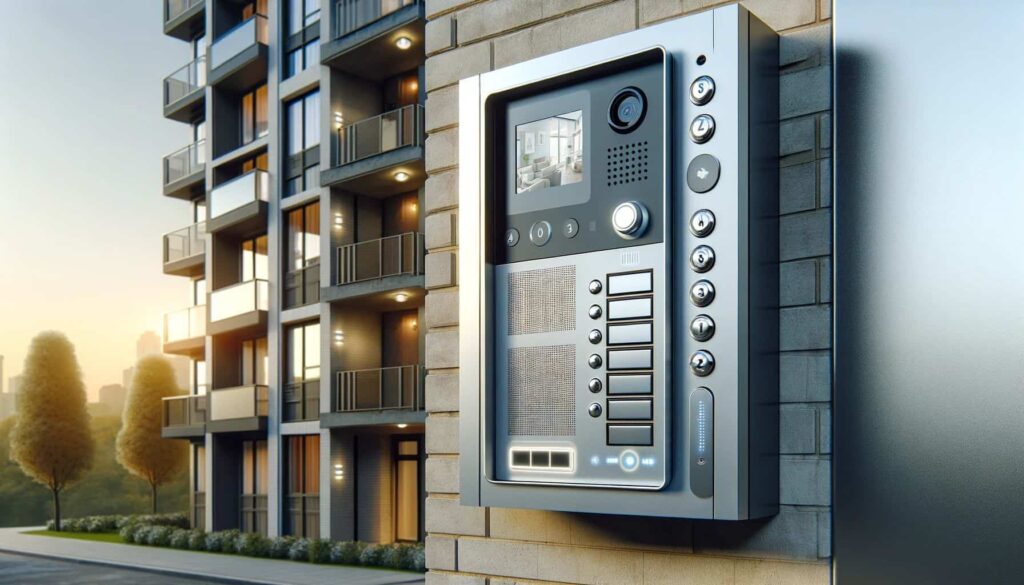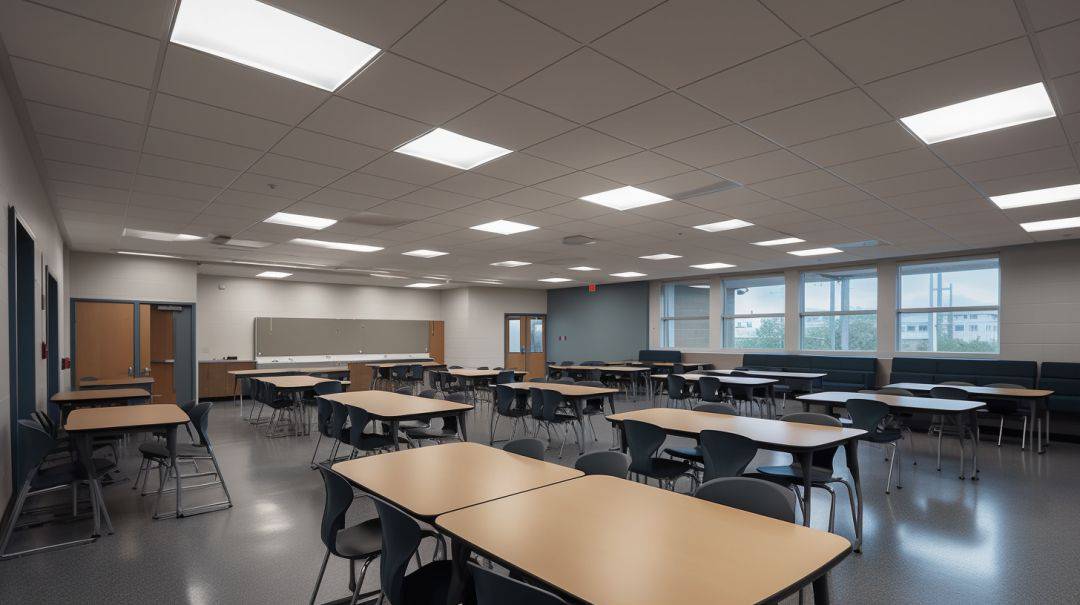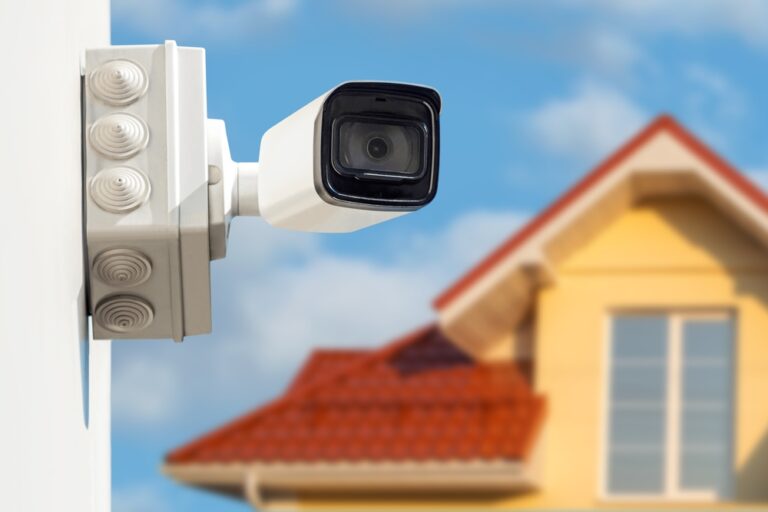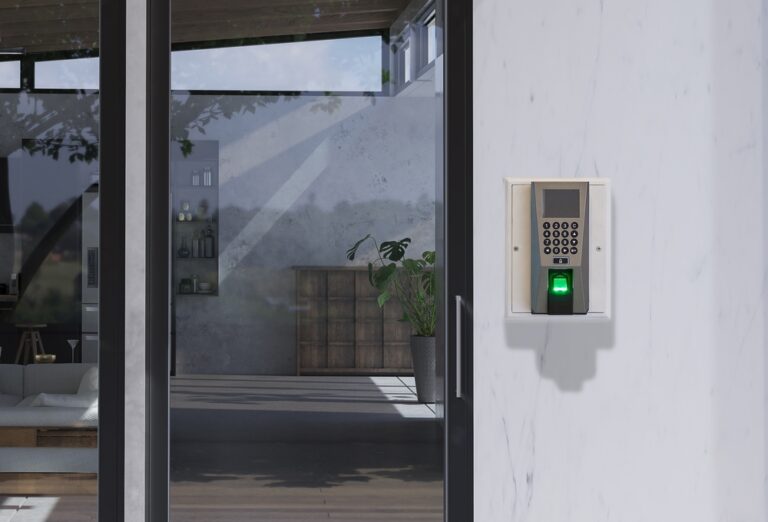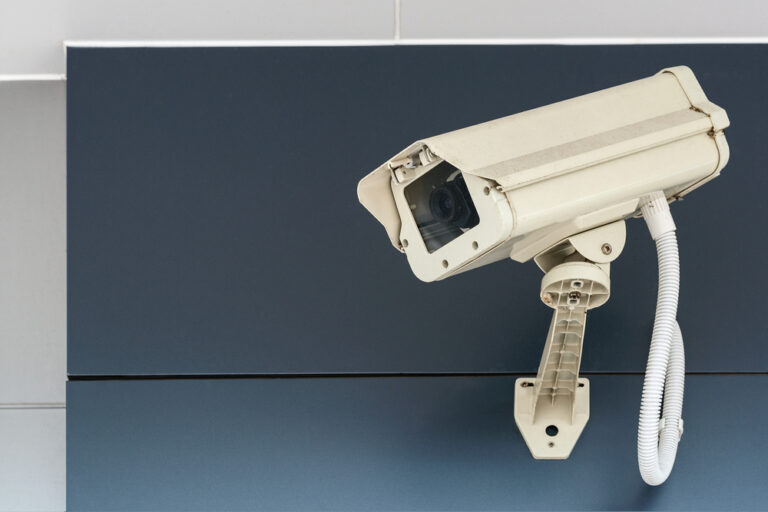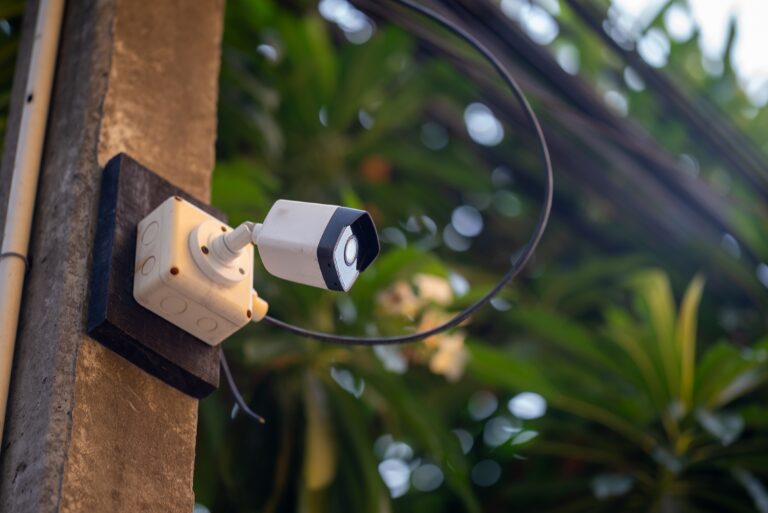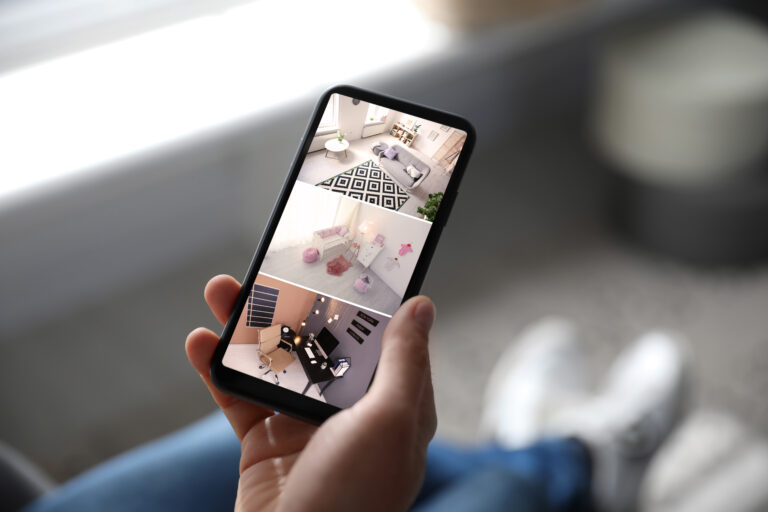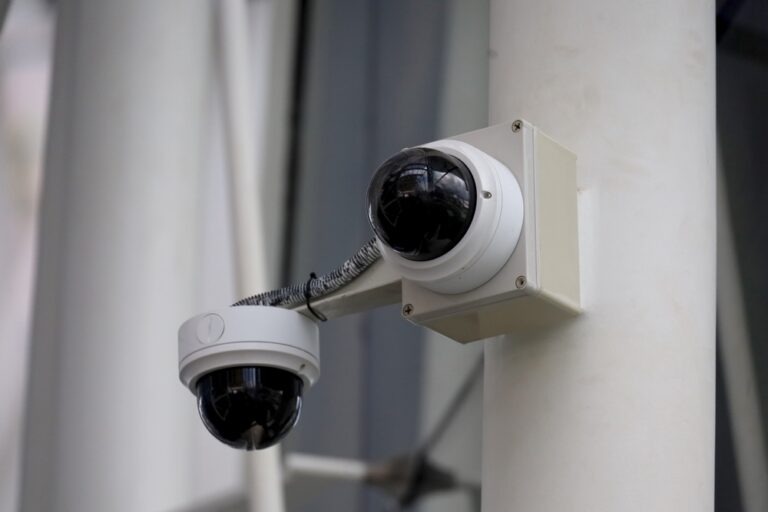- 1) Benefits of Having an Apartment Intercom System
- 2) Types of Apartment Intercom Systems
-
3)
Factors to Consider When Choosing an Apartment Intercom System
- 3.1) Mobile App Compatibility
- 3.2) Wired or Wireless Infrastructure
- 3.3) Video Intercom Capabilities
- 3.4) Integration With Other Systems
- 3.5) Touchless Access Provisions
- 3.6) Support for Multiple Building Entrances
- 3.7) Remote Administration and Maintenance
- 3.8) Budget Requirements
- 3.9) Weatherproofing Specifications
- 3.10) Multi-Unit Scalability Provisions
- 4) How Apartment Intercom Systems Work
- 5) Importance of Apartment Intercom Systems for Building Security
- 6) Choosing the Best Intercom System for Your Apartment Building
- 7) The Latest Innovations in Apartment Intercom Technology
- 8) Benefits of IP Apartment Intercoms
- 9) Conclusion
-
10)
FAQs
- 10.1) What are the main types of apartment intercom systems?
- 10.2) How does an apartment intercom system enhance building security?
- 10.3) What key considerations determine ideal apartment intercom selection?
- 10.4) How can smart mobility integrations augment an apartment intercom system?
- 10.5) Why transition from analog to IP-based apartment intercom platforms?
Protecting a residential property with reliable communication and controlled access is more crucial now than ever. An apartment intercom system provides that vital capability to multi-unit housing complexes by enabling secure resident entry, guest screening, and building monitoring.
| Key Takeaways |
|---|
| Modern IP apartment intercoms provide vital access control layers while improving living standards via mobility integrations and smart community connectivity. |
| Key system selection considerations span feature specifications, building infrastructure provisions, compliance requirements and provider solution capabilities catering to unique needs. |
| Multifaceted security and oversight enhancements like restricted access authorization, visitor logging, interfaced camera feeds and emergency coordination empowered by intercoms fortify apartment complexes. |
| Interoperability with access control systems, home automation platforms and building management infrastructure via APIs enhances intercom utility extensively. |
| Leading customized solution crafters like Jefferson Security join tailor-made IP intercom configurations with extensive professional services ensuring user-centric long term viability. |
As apartment buildings house numerous residents and regular visitors, effective entry management and restricted access is essential to prevent unauthorized intrusions that could compromise safety. Modern intercom systems facilitate keyless entry for residents while providing optimal oversight on guest arrivals to increase accountability.
An intercom also improves onsite communication between management, residents and visitors. The technology continually evolves to leverage the latest advancements for enhanced performance and intelligent integrations. An optimally designed system enhances living standards and safeguards the residents and premises from external threats.
This extensive guide examines the multifaceted importance of implementing a state-of-the-art apartment intercom setup. We explore the key benefits, main types, vital factors to consider, functionality, impact on security, latest advancements and optimal system selection criteria. Equipping your multifamily housing complex with an advanced intercom system ensures the community resides in a comfortable, protected environment.
Benefits of Having an Apartment Intercom System

Installing an intercom system in an apartment building provides multifaceted security, communication and convenience benefits for both residents and property managers. The key advantages include:
Increased Security
- Restricts access to only authorized individuals with keyless entry provisions for residents
- Enables screening of visitors before granting entry
- Integrates with surveillance cameras for video verification
- Sends alert notifications upon unauthorized access attempts
- Deters criminal activities by enhancing oversight
Enhanced Communication
- Enables two-way audio communication with visitors
- Residents can speak with front desk staff
- Public announcements can be made by management
- Facilitates communication between maintenance staff and residents
Improved Resident Experience
- Keyless entry for residents enhances convenience
- Hassle-free guest entry procedures
- Integration with smart home platforms (Alexa, Google Home)
- Modern mobile application for access control
- Overall upgraded living standards and satisfaction
The right apartment intercom system significantly bolsters community safety while delivering optimal accessibility, oversight and quality of life enhancements for those residing on the premises.
Types of Apartment Intercom Systems
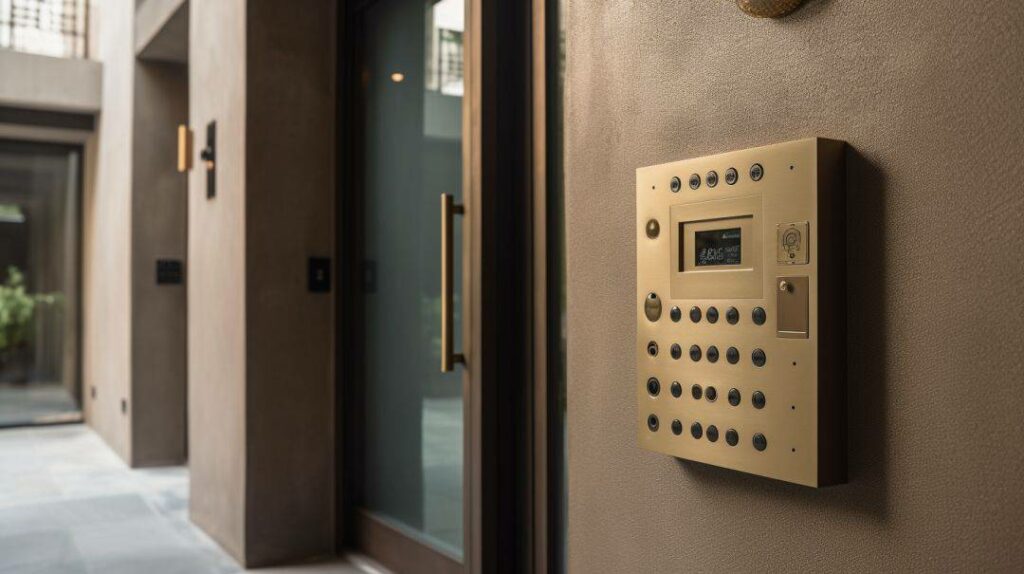
Apartment intercoms utilize an external panel installed next to pedestrian or vehicle access points, connected with internal panels within individual units. Various infrastructures transmit communication and open door locks upon access authorization. Main types include:
Wired Intercoms
Wired intercom systems use physical cables and wires to connect all components, transmitting data through copper telephone cables or CAT5e/CAT6 data cables. They deliver superior reliability but entail complex installation.
Wireless Intercoms
Wireless intercom systems utilize encrypted wireless mesh network technology for cable-free convenience. They provide flexible installation using battery-powered or hardwired components without wiring apartments.
Telephone Entry Systems
Telephone entry intercoms leverage existing phone lines within a building to transmit communication and access control signals. They interface with the existing phone infrastructure for straightforward installation.
Video Intercoms
Video intercom systems incorporate IP surveillance cameras on external panels and interior stations to enable video verification. Visitors’ identities can be visually confirmed before granting access for maximum security.
Determining intercom infrastructure guidelines and feature requirements is vital for optimal performance. Consulting intercom specialists will ensure the right solution is deployed for your apartment building.
Factors to Consider When Choosing an Apartment Intercom System
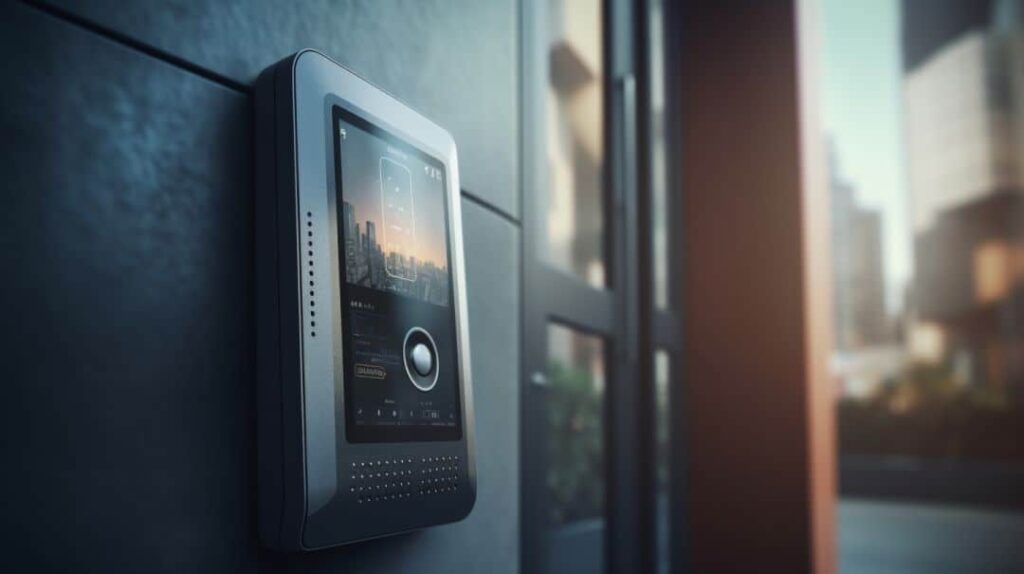
Finding the ideal access control and resident/visitor communication system for an apartment complex entails meticulous evaluation of key factors depending on building requirements:
Mobile App Compatibility
Enabling residents to interface with the intercom via smartphone introduces tremendous convenience and control. Confirming visitor arrivals, granting access permissions and public announcements can be facilitated remotely through multi-platform mobile apps instead of relying solely on physical panels.
Modern systems integrate iOS and Android compatibility with push notifications, delivering instantly accessible intercom monitoring and seamless access management from anywhere. These provisions considerably amplify system effectiveness.
Wired or Wireless Infrastructure
The physical infrastructure underlying intercom technology requires assessing a building’s cabling provisions and pathways to determine viability of:
- Wired intercom systems utilizing telephone and data cables, provide failproof reliability and performance by eliminating interference risks associated with wireless platforms. However, installing wires through the walls of existing structures entails demolition and restoration.
- Alternately, wireless intercom technology transmit signals through encrypted radio frequencies or wi-fi, circumventing the need to physically connect system components. They facilitate rapid deployment with versatile, non-invasive positioning using battery or electrical power options. Hybrid combinations enable wiring central hubs while devices connect wirelessly, providing versatile, scalable infrastructure.
Video Intercom Capabilities
Incorporating a surveillance camera into external panels, interior stations and mobile interfaces grants indispensable video verification of visitor identities prior to access authorization. This visual authentication capability provides significantly enhanced security, especially crucial for gated communities and urban multifamily housing.
High-resolution imagery, color night vision, infrared and motion detection constitute some discerning metrics while evaluating camera performance. Visitors face a captured visual record when requesting entry, deterring miscreants. Advanced deep learning analytics can also recognize familiar resident faces for keyless entry when integrated with facial recognition platforms and smart home systems.
Integration With Other Systems
The capabilities of modern intercom systems can be tremendously augmented through integration with other prevalent building platforms including:
Access Control Networks: Connecting the intercom infrastructure with the access control panels that govern credentials for swipe cards, key fobs or touchpads provides a crucial unified view. Now both visitor and resident entry events can be monitored/managed through a common interface, ensuring no unauthorized access slips through an oversight gap between disparate systems.
IP Video Surveillance Camera Feeds: Further enhancing oversight by interfacing the footage captured by CCTV cameras covering building grounds with intercom video enables responding personnel to instantly view events leading up to an intercom visitor exchange. Integrated camera feeds afford additional visual authentication of visitors while unified dashboards help coordinate response actions faster.
Smart Home/IoT Infrastructure: Allowing hands-free voice-based remote operation of an intercom system via smart assistants enhances management convenience significantly. Whether housed inside a resident’s kitchen or externally covering the entrance area, smart speakers with Alexa/Google integration can provide intercom access via home automation platforms.
Touchless Access Provisions
Minimizing contact with frequently used communal surfaces has become vital across public spaces and multi-unit housing. Intercom systems can either natively support or be configured to work with various touchless access technologies for infection control:
- Facial Recognition Cameras: Confirming identity by detecting resident facial biometrics enables keyless entry
- Iris/Fingerprint Scanners: Matching resident eye/finger scans against pre-stored templates authorizes automated door unlocks
- RFID/Bluetooth/NFC: Detecting resident smart cards, phone tags or wristbands via various wireless mechanisms can authenticate and enable door access.
Support for Multiple Building Entrances
Larger multi-story apartment complexes incorporate more than one lobby entrance and have separate access points for underground garages, side doors or emergency exits. Scalable intercom systems equipped with sufficient hardware capacity can extend oversight and access management across numerous ingress locations.
Instead of needing fragmented solutions covering individual doors, modern centralized platforms even enable managing dispersed buildings across large campuses from a single intuitive interface. Whether enhancing perimeter access or internal hallway authorizations, comprehensive control improves security.
Remote Administration and Maintenance
Web-based and mobile management interfaces enable authorized personnel to handle multiple aspects remotely:
- Managing resident credentials
- Configuring access permissions
- Adding/updating visitor entries
- Performing diagnostics to identify issues
- Monitoring equipment status
- Initiating over-the-air firmware/software updates
- Examining entry logs and events
This allows efficient centralized administration without requiring onsite presence.
Budget Requirements
Intercom systems scale to serve diverse budget ranges depending on model specifications without compromising durability, functionality or essential performance metrics. Understanding fiscal constraints and finding the right combination of features balancing affordability and reliability ensures long-term value.
Weatherproofing Specifications
Associated hardware meant for exterior installation like panels, call boxes and door stations must provide suitable protection levels safeguarding internal circuitry from:
- Wind, Dust and Rain Exposure
- Temperature Fluctuations Through Season Changes
- Humidity and Corrosion Risks
Carefully vetting equipment build quality ensures flawless outdoor operation.
Multi-Unit Scalability Provisions
System design should facilitate straightforward expansions accommodating additional building units through scalable device capacities. Component modularity further eases maintenance by allowing rapid replacements or upgrades without needing full infrastructure overhauls. This ensures graceful support through ongoing changes.
How Apartment Intercom Systems Work

Modern IP-based apartment intercoms incorporate a multifaceted infrastructure enabling versatile access control, seamless communication, intuitive management and intelligent integration capabilities. The various components and their vital interworking comprises:
External Panel Station
Installed adjacent to building access points, these sturdy weatherproof panels comprise backlit directory menus, call buttons, screens, cameras, card/code readers and door controls. Visitors scroll resident listings and initiate calls. Integrated sensors authenticate access when authorized.
Interior Stations
Wall-mounted touchscreen stations within apartments facilitate receiving audio/video calls from external panels. Residents view live feeds, communicate with visitors, provide access permissions and manage automated doors/gates securing community entry points.
Distribution Modules
These central hardware hubs installed in protected utility areas process and direct all system data including access requests, audio/video transmission between panels and interior stations while interfacing with door locks. Some systems utilize existing building LAN infrastructure.
Management Server
Central server hardware supports running system software that configures access settings, maintains user/credentials database and logs all events. It can interface with various integration platforms using API endpoints and connects the infrastructure over secure VPN tunnels facilitating remote administration.
Mobile Application
Smartphone apps enable residents to view panel station feeds remotely and achieve complete intercom functionality including communicating with visitors, operating building access points and configuring system parameters.
The modular infrastructure provides a versatile canvas allowing developers to craft innovative use cases and add advanced capabilities through regular software updates. Interfacing with supporting hardware and external platforms multiplies intercom utility significantly.
Importance of Apartment Intercom Systems for Building Security
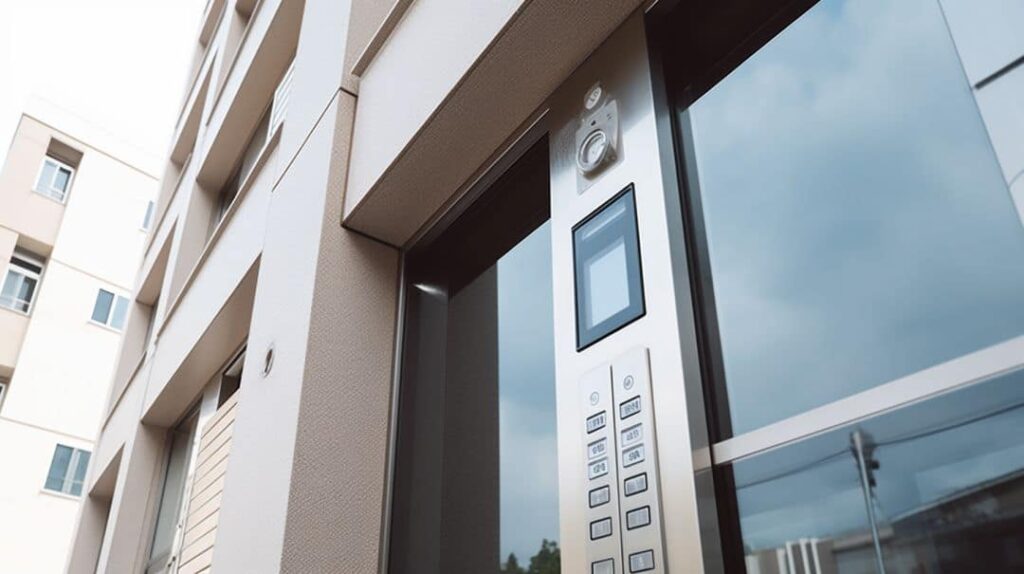
Installing a modernized apartment intercom system constitutes one of the most vital access control and oversight investments toward fortifying a multi-unit residential building against external threats, maintaining compliance and safeguarding those who dwell within the premises.
Restricts Unauthorized Entry
Intercoms enable screening visitors, verifying identities and granting selective access permissions for entry points including lobbies, garages and side entrances based on credentials and authorizations. This forms the first line of defense by filtering guest arrivals and blocking intrusions.
Deters Criminal Activities
The presence of interfaced surveillance cameras, two-way audio communication, smart intrusion detectors and remotely operable doors/gates provides significant deterrence against trespassing, break-ins or vandalism. Criminals recognize the heightened visibility and risk of being identified.
Maintains Regulatory Compliance
Stringent legal requirements govern access protocols, audit trails and video data retention for multi-dwelling residential facilities. Modern intercom systems ensure building owners continually meet safety and administrative compliances through software-managed protocols.
Enhances Emergency Response
Bi-directional intercom communication, instant notifications and real-time visual verification empowers personnel to coordinate faster emergency action. First responders can be apprised on situations as they develop for swifter assistance.
Improves Insurance Terms
Documented access control layers, surveillance provisions, regulatory conformance and prompt emergency response enabled by integrated intercom systems qualify buildings for lower premiums, deductibles and favorable insurance clauses thereby reducing overheads.
Choosing the Best Intercom System for Your Apartment Building
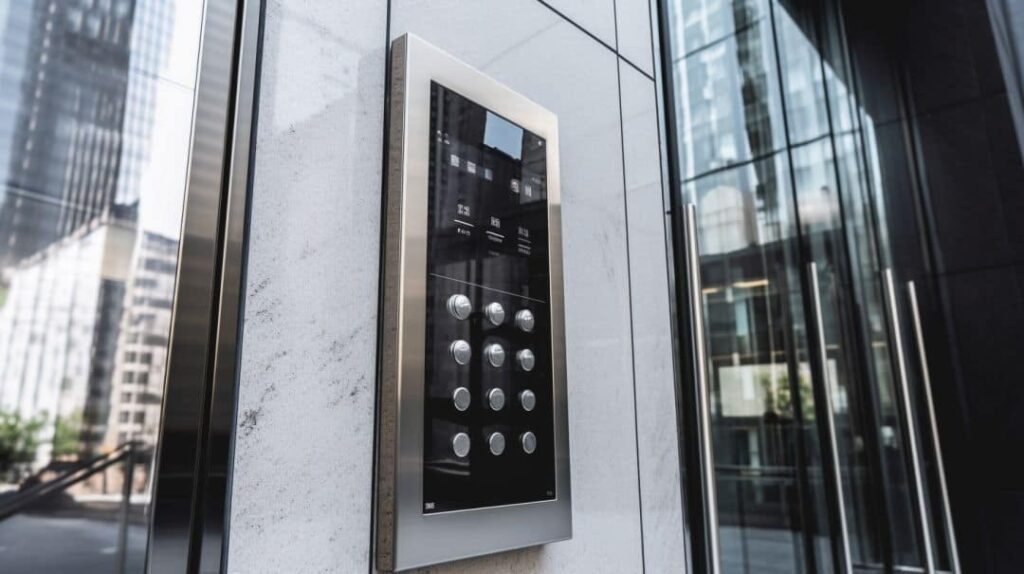
Selecting an optimal intercom solution catering to the unique requirements of an apartment complex entails considerate evaluation across numerous aspects from technical specifications to service capabilities.
Determine Essential Features
Establishing clearly defined needs around access points, audio/video quality, integration necessities, mobile access, failover provisions etc constitutes a vital first step.
Assess Infrastructure
Evaluating existing wiring provisions, entry points, power sources and local IT assets allows designing infrastructure appropriately. Consider scalability for future expansions.
Compare Provider Offerings
Research various intercom system developers and compare service capabilities, equipment quality and feature sets aligning with your specifications checklist.
Validate Compliance Scope

Confirm solution’s capacities toward meeting ongoing safety, security and data privacy legal obligations for rental properties in your state.
Verify Support Reliability
The service partnership formed with your intercom provider can make/break system viability long-term. Verify capabilities around remote diagnostics, maintenance commitments, response times, training availability etc.
Request Custom Solution
Leading developers like Jefferson Security craft tailored intercom systems specific to your building’s needs, optimizing functionality.
The Latest Innovations in Apartment Intercom Technology
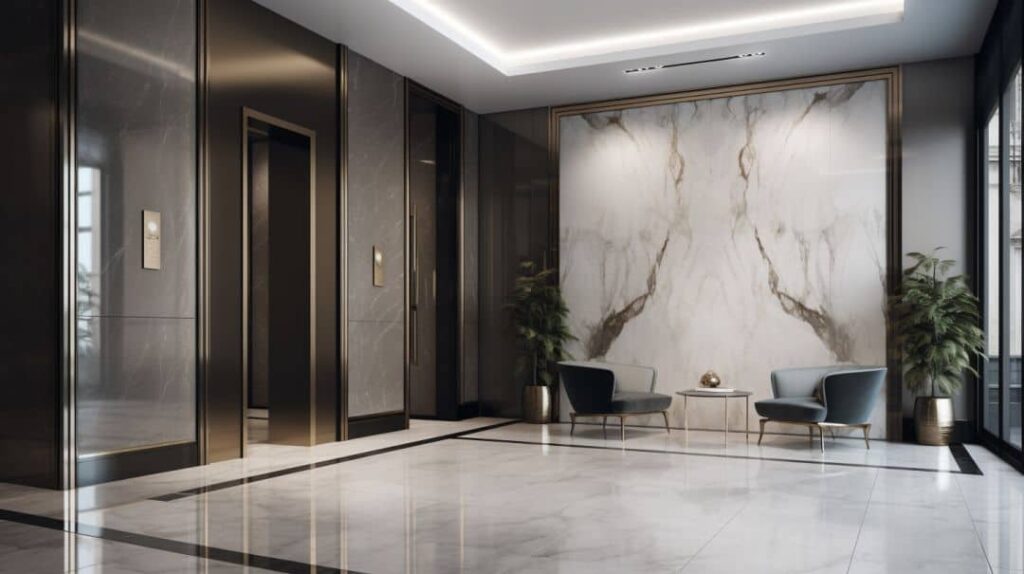
Apartment intercom systems continue gaining tremendous utility driven by rapid integration of innovations like:
Mobile App Compatibility
Native interoperability with iOS/Android apps via Bluetooth/WiFi provides unmatched flexibility in access control, visibility and system adjustments.
Wireless Capabilities
Leveraging mesh networks and PoE interfaces eliminates complex wiring allowing quick deployments. Some systems operate cable-free powered by batteries/solar panels.
Integration with Other Systems
Embedded API and IoT protocols enable seamless connections with surveillance systems, automation platforms and building management infrastructure for consolidated functionality.
Touchless Access
Integrated sensors facilitating keyless entry via phones or biometrics like face/palm confirmation reduces infection risks and enhances convenience.
Advanced Analytics
On-board machine learning and vision algorithms enable recognizing faces, suspicious behaviors and hazards like leaks/fires triggering alerts.
Cloud-native software orientated designs focused on mobility, extended connectivity and deeper integrations continue multiplying apartment intercom capabilities while simplifying management overhead.
Benefits of IP Apartment Intercoms

Internet protocol (IP) driven designs empower modern apartment intercom systems with an extensive range of enhancements spanning communication, convenience, customization, intelligence and administrative capabilities:
Enhanced Communication
Digital audio components leverage noise-cancellation and harness high dynamic range to remove distortions. HD video enables crisp imagery so security personnel can clearly recognize visitor faces. Such enhancements lead to positive resident interactions.
Straightforward Installation
Ethernet compatibility allows conveniently tapping into existing community network wiring across buildings to simply plug intercom modules without extensive cabling. PoE provisions further simplify running power.
Ubiquitous Remote Access
Intercoms operate as securely accessed networked appliances. Residents employ purpose-built mobile apps on smartphones and administrators access intuitive web dashboards enabling system control/oversight from anywhere without distance constraints imposed by hardwired analog hardware.
Seamless Integration
Incorporating open APIs and maintaining software interoperability with security and automation systems allows IP intercoms to interface as holistic smart community hubs gathering inputs from various sensors, cameras door controllers into consolidated interfaces optimizing management.
Scalability
The networked architecture centered around a main server augmented by connectable IP end-points streamlines expanding intercoms as needs arise. Adding doors, cameras and interior stations entails simple license upgrades and plugging components without expensive core infrastructural changes.
Cost-Effectiveness
Unlike analog systems demanding discrete wiring and hardware servicing every door, IP intercoms adopt a centralized architecture that enables sharing network infrastructure, servers and gateways across properties. This allows stretching investments through distributing resources that get utilized across connected endpoints.
Advanced Features
The networked platform allows developers to regularly enhance capabilities through feature-rich firmware/software updates that augment functionality. Capabilities like applying custom automation routines, adding interactive protocols to engage visitors, integrating with home developments and even enabling entirely touchless access adoption can be smoothly rolled out across deployed hardware.
Enriched Visitor Experience
IP Intercoms present a smarter interface for guests via crisp displays, intuitive buttons, conversational voice prompts and callbacks to resident mobile devices. Integrations with automation apps also enable registered visitors to trigger customized greetings, music and lighting based on preferences improving reception.
Centralized Remote Administration
On-premise servers can be entirely managed from distant locations through online connectivity. Administrators handle user provisioning, run diagnostics to resolve technical issues, monitor equipment health metrics and track events logs without needing in-person site visits. This enables efficient centralized upkeep while cutting overhead costs significantly.
Conclusion
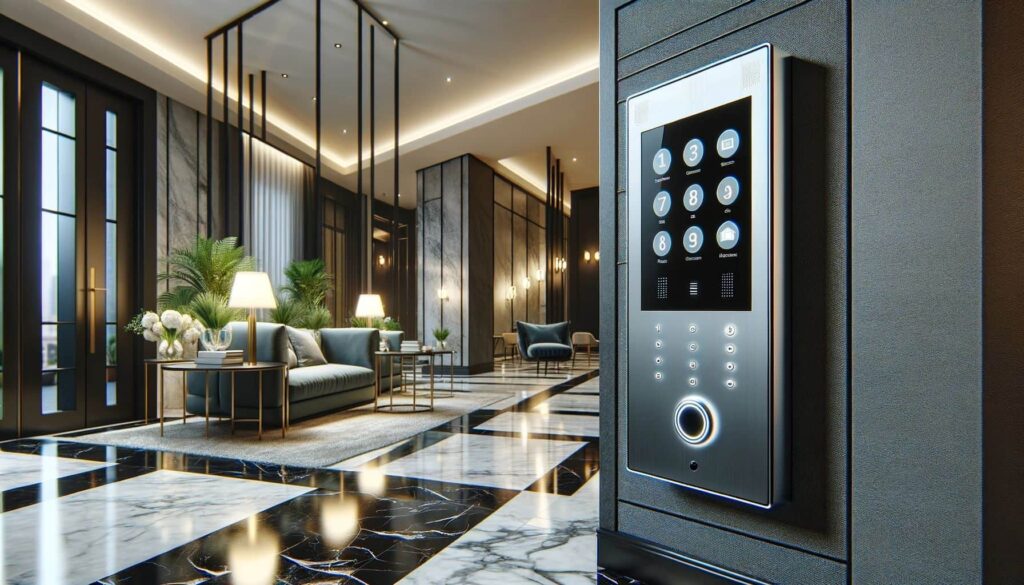
Installing a high-quality IP-based intercom system constitutes one of the most prudent investments toward fortifying apartment building security, enhancing resident living standards and easing administrative overheads. The multifaceted benefits spanning access control, instant remote oversight, compliance enablement, emergency coordination and insurance merits make intercoms vital for housing communities.
Advancements around expanding IoT connectivity, mobility-centric control apps, support for sophisticated integrations and touchless technologies continue augmenting system capabilities while simplifying management. As needs arise, modern intercoms can gracefully scale to accommodate additional access points and even whole new building units through their adaptable network-centric designs without requiring extensive hardware replacements.
Selecting optimal solutions catering to your community’s unique specifications warrants prudent research. However reputed providers like Jefferson Security Cameras craft customized IP intercom systems tuned specifically for apartment complexes. Their tailor-made configurations joined by dedicated professional services support long-term ensure maximum infrastructure resilience, steadfast security and peace of mind.
FAQs
What are the main types of apartment intercom systems?
The predominant intercom infrastructure options include wired systems utilizing telephone or data cabling, wireless platforms leveraging encrypted transmissions, telephone-based systems interfacing with existing building phone infrastructure and video intercoms with integrated surveillance cameras.
How does an apartment intercom system enhance building security?
Intercoms restrict unauthorized access by screening visitors, verifying identities, integrating with access control layers enabling selective entry permissions while creating monitoring transparency through logged events and interfaced surveillance feeds to deter criminal activity.
What key considerations determine ideal apartment intercom selection?
Vital aspects spanning feature necessities, building infrastructure provisions, provider solution capabilities, compliance requirements and long term service support reliability must be evaluated to choose optimal apartment intercom systems catering to unique specifications.
How can smart mobility integrations augment an apartment intercom system?
Incorporating bluetooth and WiFi connectivity to interface with residents’ iOS/Android smartphones via proprietary apps brings unmatched flexible control, real-time visibility and remote management without relying solely on fixed interior panels.
Why transition from analog to IP-based apartment intercom platforms?
IP intercoms deliver enhanced audio/video quality, ubiquitous remote access through apps/web dashboards, seamless integration potential with security and automation systems, scalable accommodating expanding needs and centralized cloud-enabled administration capabilities.

